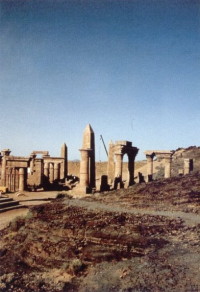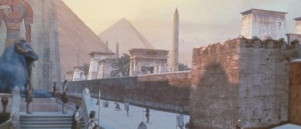
Principal photography for The Mummy began in
Marrakech, Morocco on Monday, May 4, 1998
on the Cairo Prison set, the start of a
seventeen week schedule of filming in
Morocco, the United Kingdom Filming
completed on Saturday, August 29, 1998.
 Although The Mummy is very much an Egyptian story, the political
climate in Egypt during the pre-production period made it impossible
to set up such a major movie with all its inherent logistical
problems. A decision was made to shoot the complicated location
sequences in Morocco, with Marrakech providing the casbahs and
bazaars of 1925 Cairo. The ruins of the lost city of Hamunaptra, the
legendary City of the Dead, would be built in the Sahara desert
outside the small town of Erfoud.
Although The Mummy is very much an Egyptian story, the political
climate in Egypt during the pre-production period made it impossible
to set up such a major movie with all its inherent logistical
problems. A decision was made to shoot the complicated location
sequences in Morocco, with Marrakech providing the casbahs and
bazaars of 1925 Cairo. The ruins of the lost city of Hamunaptra, the
legendary City of the Dead, would be built in the Sahara desert
outside the small town of Erfoud.
B ut what were the problems of setting up a movie the size and scale
of The Mummy in Morocco? This mammoth task was the
responsibility of experienced co-producer Patricia Carr who seems
to have cornered the market in desert movies, having worked in the
Sahara Desert on Star Wars in 1976 and Raiders of the Lost Ark in
1980; the Arizona and Yuma deserts on Return of the Jedi in 1982;
and the deserts of Jordan and Spain on Indiana Jones and the Last
Crusade in 1988.
 "We had to do a great amount of work in a
relatively small amount of time," says Carr.
"But after meeting with the local city officials,
we were able to get medical cover in place, as
well as arrange all the catering and
transportation and have everything completed in
record time." .
"We had to do a great amount of work in a
relatively small amount of time," says Carr.
"But after meeting with the local city officials,
we were able to get medical cover in place, as
well as arrange all the catering and
transportation and have everything completed in
record time." .
For the cast, the Moroccan locations were exotic but the conditions
proved extremely difficult to shoot in, given the heat, the sandstorms
and the rebellious camels. .
Hannah says, "Filming in Morocco was quite an experience. The
biggest challenge was maintaining the energy level right up to the
start of the scene. It was really hot out there, and the snakes and
scorpions and the spiders made it difficult to keep focus and your
enthusiasm." .
Fraser adds, "The whole shoot was a bit risky, a little frightening.
They had real charging horsemen coming at us with lots of blank
gunfire. It was good fun though."
.
The actors did receive a fair amount of training to ride camels at fast
speeds, and were given weapons and ammunitions training to
prepare for the battle scenes.
.
"According to Stephen, all I had to do was turn up, shoot guns and
'look like a stud,'" says Fraser.
.
O'Connor adds, "The worst thing I was asked to do on this movie
was to ride a camel. I was given lessons but I think I could spend an
eternity learning how to do it, and still never master it. I don't think I'll
ever go on a camel again."
.
 Temperatures of 130 degrees in the early morning were
commonplace during the production, but the producers knew that if
they were to shoot the film anywhere in the United States it would
look too much like the original Mummy films. Sommers was
persistent in his requests that the film be shot on location.
.
Temperatures of 130 degrees in the early morning were
commonplace during the production, but the producers knew that if
they were to shoot the film anywhere in the United States it would
look too much like the original Mummy films. Sommers was
persistent in his requests that the film be shot on location.
.
In The Mummy, Hamunaptra is the hidden city in the desert which
rises from the ground when our treasure-seeking heroes approach.
But to try and create this magical fortress on film presented a huge
challenge for the production. Researchers pouring over books on
Egyptian architecture and Egyptian life found no information on the
existence of such a city, so the creative brain power had to be at its
peak. .
Production Designer Allan Cameron, who had also previously
worked with Sommers on Rudyard Kipling's The Jungle Book, was
the kind of go-getter Sommers needed to get things going. Almost
immediately, Cameron found a dormant volcano near the town of
Erfoud, where the entire set for the City of the Dead could be built.
.
Sommers says, "I trust Allen to find any location-he did the same
on The Jungle Book. You give Allan a plane ticket and send him out,
and he'll find pretty much everything we need."
.
"When Allan discovered the volcano I knew we had to use it," says
Sommers. "A city hidden in the crater of an extinct volcano made
perfect sense. Out in the middle of the desert you would never see
it. You would never think of entering the crater unless you knew
what was inside that volcano." .
Says Cameron, "The volcano was the most important exterior set
we had. The lost city of Hamunaptra is where the majority of the
action takes place, either above ground or in the passageways and
chambers underground, so the right look was of utmost
importance." .
He adds, "Once I found the location, we did a whole survey of the
volcano so we had all the dimensions to take back to Shepperton
Studios where we made a model of the volcano and scale models of
the columns and statues and bases and then really planned out how
it would best work for the action."
.
Several of the sets were built with special effects which enabled the
city to fall down and collapse. Columns were made out of fiberglass
covering an interior metal structure, with special-effects rigs inside
that. The rest were made out of plaster.
.
In the end the set took 16 weeks to construct and was then
destroyed on camera. The result is truly a staggering visual
achievement, and one of the highlights in the film.
.
As for moving a production crew necessary for the size of a project
like The Mummy, Carr had more than enough on her plate.
.
"It was not easy finding enough hotel rooms in a small desert town
which only caters to tourists who stay for one night or two at the
most," says Carr, "and the desert region of Morocco is becoming
more and more popular with tourists because of the current political
troubles in Egypt." .
The accommodation problem grew much worse in mid-May when
the production began filming in Erfoud and there were 800 people to
accommodate (which included cast and crew as well as over 200
Tuareg horsemen and 80 Legionnaires).
To create the underground passageways of the City of the Dead,
interior sets were built at Shepperton Studios, the legendary sound
stages in London where many mammoth film productions have shot
in the past.
The most visual," continues Cameron, "was probably the huge,
rat-infested underground necropolis which had a large cemetery
surrounded by a detritus moat with human remains bobbing in the
goo. Then there was the cavernous treasure chamber, filled with lots
of golden statues and trinkets."
 Another enormous undertaking was the exterior set constructed in
the United Kingdom on the historic dockyard at Chatham, which
stood in for the Giza Port on the River Nile. The set was 600 feet in
length and contained a steam train, an Ajax traction engine, three
cranes, an open two-horse carriage, four horse-drawn carts, five
dressing horses and grooms, nine pack donkeys and mules, as well
as market stalls, Arab-clad vendors and room for 300 costumed
extras."
Another enormous undertaking was the exterior set constructed in
the United Kingdom on the historic dockyard at Chatham, which
stood in for the Giza Port on the River Nile. The set was 600 feet in
length and contained a steam train, an Ajax traction engine, three
cranes, an open two-horse carriage, four horse-drawn carts, five
dressing horses and grooms, nine pack donkeys and mules, as well
as market stalls, Arab-clad vendors and room for 300 costumed
extras."
O'Connor says, "I'm glad we filmed the locations in the desert at the
beginning of the schedule. If we shot the interiors at Shepperton
Studios first, that would have been tough. It was great to get through
those Moroccan locations while everyone still had so much energy."
B
ut the actors knew that an epic about an expedition of explorers in
the Sahara desert would be an intimidating task for anyone. In fact,
Weisz was called upon to endure some of the most horrific scenes
in the movie, a task for which she was more than prepared for.
W
eisz says, "I was manacled to an altar with live rats clamoring all
over my body for a whole week. In another scene I had four-inch-long
live locusts poured over my head and entangled in my hair."
Despite the unsavory demands placed upon the cast, everyone
involved in the production had nothing but raves for director
Sommers.
F
raser says, "Stephen is constantly on the move, he has boundless
energy. He has the ability to accept suggestions and the courage to
try everything. He constantly told us to 'play with it', which is really a
freeing experience. He knows how to direct an action picture...he's
fast, he's quick, and every shot counts."
W
eisz adds, "He's got more energy than any person I have met.
He's really inspiring and fun. He's got a wonderful sense of humor
and, because he wrote the script himself, it's all in his imagination."
"Steve really cares about this movie and he has obviously given it a
lot of thought. It jumps so much from place to place, from scene to
scene, but Stephen seems to have really thought everything out in
terms of the story," says O'Connor.

Information from

